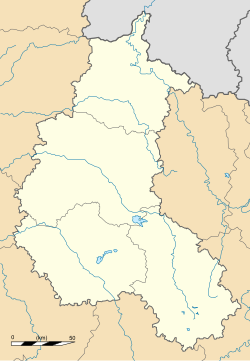| Fortress of Charlemont | |
|---|---|
Fort de Charlemont | |
| Near Givet | |
 The Fortress of Charlemont and the village of Givet. | |
| Site information | |
| Type | Fort |
| Location | |
| Coordinates | 50°08′09″N4°48′13″E / 50.135833°N 4.803611°E |
| Site history | |
| Built | 1555 |
The Fortress of Charlemont (French : Fort de Charlemont) is a French stronghold located near the Belgian border on the Meuse. It is a citadel, surrounded by a network of outworks, [1] including the connecting forts (Givet and the Mont d'Hours). [2] It dominates the town of Givet and when in use as a working fortress controlled the valley of the Meuse.
Contents
- Destruction within the fort after the First World War.
- view of the fort from within Givet.
- The Maugis Tower.
- Between Condé Charlemont Covered Path.
- Entrance to Fort Condé.
- Staircase, the only access point from the glacis to the fort.






